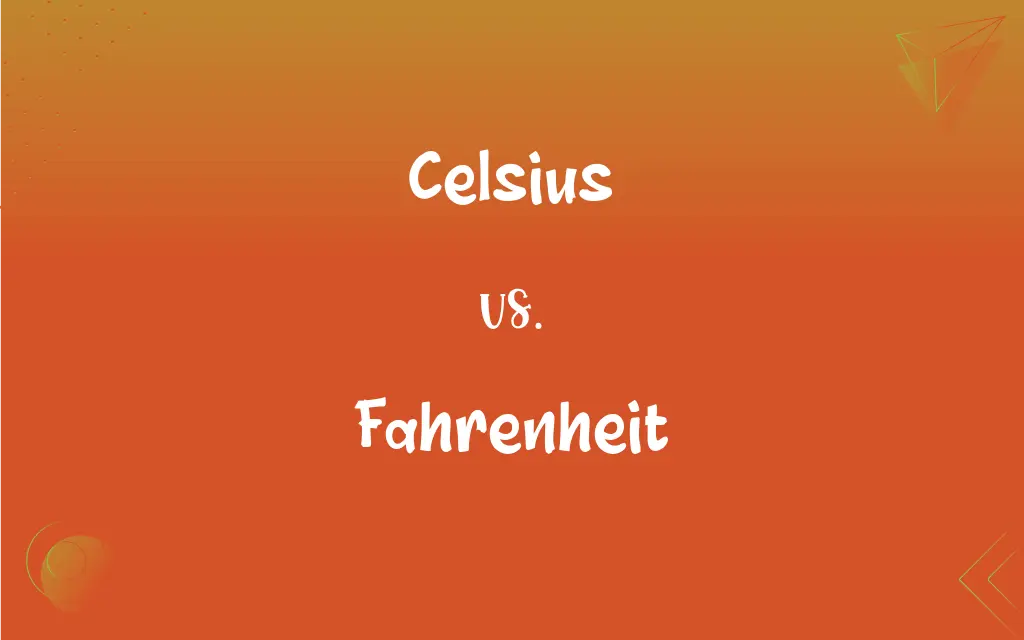Celsius vs. Fahrenheit: What's the Difference?
Edited by Aimie Carlson || By Harlon Moss || Updated on October 17, 2023
Celsius is a temperature scale where 0° represents the freezing point and 100° the boiling point of water. Fahrenheit sets 32° for freezing and 212° for boiling of water.

Key Differences
Celsius, often denoted as °C, is a widely accepted temperature scale used internationally, particularly in scientific contexts. Its main defining points are the freezing and boiling points of water, which are set at 0°C and 100°C respectively. This scale was previously known as "centigrade" due to its 100-degree interval between the freezing and boiling points.
On the other hand, Fahrenheit, represented as °F, is the temperature scale predominantly used in the United States and its territories. In this scale, the freezing point of water is at 32°F, and the boiling point is at 212°F. This difference in reference points results in a unique temperature conversion formula between the two scales.
While Celsius tends to be more intuitive for those thinking in base-10 due to its relation to the metric system, Fahrenheit offers finer gradations between degrees, which some argue gives a better "feel" for temperature in everyday life. For instance, in Fahrenheit, ambient temperatures for most inhabited regions on Earth typically fall between 0° and 100°, offering a sense of scale.
Historically, the Fahrenheit scale was proposed earlier, in the early 18th century, by Daniel Gabriel Fahrenheit. The Celsius scale came a few decades later, introduced by Anders Celsius. Over time, the world largely transitioned to Celsius for consistency, especially after the adoption of the metric system, while the U.S. retained Fahrenheit for customary measurements.
Comparison Chart
Freezing Point of Water
0°C
32°F
ADVERTISEMENT
Boiling Point of Water
100°C
212°F
Historical Origin
Proposed by Anders Celsius in the 18th century
Introduced by Daniel Fahrenheit in the 18th century
Usage
Used internationally, especially in science
Predominantly used in the United States
Gradation
100 degrees between freezing and boiling points
180 degrees between freezing and boiling points
Celsius and Fahrenheit Definitions
Celsius
A metric temperature scale with water's freezing and boiling points as references.
The average room temperature is around 20° Celsius.
ADVERTISEMENT
Fahrenheit
A temperature scale with 32° as water's freezing point and 212° as its boiling point.
On a warm summer day, it might reach 85° Fahrenheit in New York.
Celsius
A successor to the "centigrade" scale, now known as Celsius.
Though it's now called Celsius, older literature might refer to it as centigrade.
Fahrenheit
The customary temperature scale in the United States and its territories.
Weather reports in the U.S. provide temperatures in Fahrenheit.
Celsius
A system where every 1°C change corresponds to a change of 1 kelvin.
A difference of 10 degrees Celsius is also a 10 kelvin difference.
Fahrenheit
A scale that provides a seemingly finer gradation in ambient temperatures.
Fahrenheit gives a wide range, with human-friendly temperatures between 0° and 100°.
Celsius
The international standard for temperature measurement in most countries.
Forecasts in Europe are typically given in Celsius.
Fahrenheit
A temperature scale in which every 1°F change does not correspond linearly to Celsius or Kelvin changes.
To convert Fahrenheit to Celsius, you can't just add or subtract a fixed number; you need a formula.
Celsius
A scale particularly used in scientific contexts due to its metric alignment.
Laboratory experiments often record results in Celsius for global consistency.
Fahrenheit
A system introduced in the 18th century by Daniel Gabriel Fahrenheit.
Daniel Fahrenheit's legacy lives on in the U.S. with the continued use of his temperature scale.
Celsius
Of or relating to a temperature scale that registers the freezing point of water as 0° and the boiling point as 100° under normal atmospheric pressure. See Table at measurement.
Fahrenheit
Of or relating to a temperature scale that registers the freezing point of water as 32° and the boiling point as 212° at one atmosphere of pressure. See Table at measurement.
Celsius
Alternative case form of Celsius
Fahrenheit
Conforming to the scale used by Gabriel Daniel Fahrenheit in the graduation of his thermometer; of or relating to Fahrenheit's thermometric scale. Used as an alternative to celsius.
Celsius
The Celsius thermometer or scale, so called from Anders Celsius, a Swedish astronomer, who invented it. It is the same as the centigrade thermometer or scale.
Fahrenheit
German physicist who invented the mercury thermometer and developed the scale of temperature that bears his name (1686-1736)
Celsius
Swedish astronomer who devised the centigrade thermometer (1701-1744)
FAQs
Which scale is older, Celsius or Fahrenheit?
Fahrenheit is older, introduced in the early 18th century.
Is Fahrenheit used globally?
No, Fahrenheit is primarily used in the U.S., while Celsius is used internationally.
Is the difference between each degree the same in both scales?
No, 1°F difference is smaller than 1°C difference.
How did Daniel Fahrenheit determine his scale's reference points?
He used several fixed temperature points, including the freezing of brine and human body temperature.
Is the boiling point of water always 100°C?
No, it can vary with altitude or pressure, but 100°C is the standard at sea level.
Which temperature scale is more accurate?
Neither is inherently more accurate; it depends on the context and precision required.
Why is Celsius preferred in science?
Its alignment with the metric system and base-10 makes it more intuitive for scientific use.
How do I convert Celsius to Fahrenheit?
Use the formula (°C × 9/5) + 32 = °F.
Which scale is used in aviation internationally?
Celsius is the international standard, including in aviation.
Who invented the Fahrenheit scale?
Daniel Gabriel Fahrenheit.
Do all scientific fields use Celsius?
Most do, but some fields in the U.S. might still use Fahrenheit.
Are there temperatures where Celsius and Fahrenheit are equal?
Yes, at -40°, both scales read the same.
Is the Kelvin scale related to Celsius?
Yes, Kelvin and Celsius have the same magnitude, but Kelvin starts at absolute zero, approximately -273.15°C.
What does Celsius measure?
Celsius measures temperature, using 0° as water's freezing point and 100° as its boiling point.
Why does the U.S. use Fahrenheit?
Tradition and historical reasons have kept Fahrenheit as the standard in the U.S.
Why is Celsius also called centigrade?
It was originally named centigrade due to its 100-degree scale, but later renamed to honor Anders Celsius.
Is 0°F colder than 0°C?
Yes, 0°F is colder than 0°C.
What's the "room temperature" in Fahrenheit?
Typically around 68° to 72°F.
How do I convert Fahrenheit to Celsius?
Use the formula (°F - 32) × 5/9 = °C.
What's the "room temperature" in Celsius?
Typically around 20° to 22°C.
About Author
Written by
Harlon MossHarlon is a seasoned quality moderator and accomplished content writer for Difference Wiki. An alumnus of the prestigious University of California, he earned his degree in Computer Science. Leveraging his academic background, Harlon brings a meticulous and informed perspective to his work, ensuring content accuracy and excellence.
Edited by
Aimie CarlsonAimie Carlson, holding a master's degree in English literature, is a fervent English language enthusiast. She lends her writing talents to Difference Wiki, a prominent website that specializes in comparisons, offering readers insightful analyses that both captivate and inform.






































































